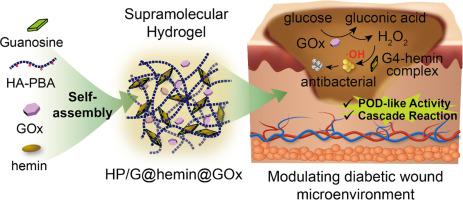Acta Biomaterialia ( IF 9.4 ) Pub Date : 2023-10-13 , DOI: 10.1016/j.actbio.2023.10.014 Xiaonong Zhang 1 , Kaixuan Ren 2 , Chunsheng Xiao 1 , Xuesi Chen 1

|
Guanosine is often used to construct supramolecular hydrogels due to its self-assembly properties, however, the high temperature and strong alkaline construction methods greatly limit its application in biomedical fields. In this work, a guanosine-driven hyaluronic acid-based supramolecular hydrogel was developed under mild condition by employing phenylboronic acid-functionalized hyaluronic acid (HA-PBA) backbone and guanosine molecules. Guanosines self-assembled into G-quartet planes under potassium ion conditions, and formed boronic ester bonds with HA-PBA, which induced rapid formation of dynamically cross-linked hydrogels. Hemin was then binding to the G-quartet plane via π-π interactions in the hydrogels, which exhibited peroxidase activity and were highly effective in killing bacteria by generating hydroxyl radicals in the presence of H2O2. Furthermore, glucose oxidase (GOx) was incorporated into the hydrogels and the HP/G@hemin@GOx hydrogels showed good antibacterial properties, modulation of wound glucose and ROS level, and good therapeutic efficacy for diabetic chronic wounds. Overall, the self-assembly of guanosine has been shown for the first time to be a feasible method for constructing natural polymer-based supramolecular hydrogels. This guanosine-driven HA-based supramolecular hydrogel can act as a potential wound dressing for chronic diabetic wound treatment.
Statement of significance
Chronic wound repair remains an unsolved clinical challenge. Herein, we propose to utilize phenylboronic acid-modified hyaluronic acid and guanosine to construct supramolecular gels with peroxidase activity for chronic wound treatment. The self-assembly behavior of guanosine drives the natural macromolecular backbone to form the hydrogel, and the proposed method simplifies the gelation conditions and improves its biosafety. The G-quartets formed by the self-assembly of guanosine can act as the loading site for hemin. G-quartet/hemin complex imported peroxidase activity to the hydrogels, endowing them with the ability to kill bacteria and regulate ROS levels of cells in the wound site. This guanosine-driven supramolecular hydrogel significantly increased the rate of wound healing in diabetic mice, promising a new strategy for chronic wound treatment.
中文翻译:

具有类似过氧化物酶活性的鸟苷驱动透明质酸超分子水凝胶用于治疗慢性糖尿病伤口
鸟苷因其自组装特性而常被用来构建超分子水凝胶,然而高温和强碱性的构建方法极大地限制了其在生物医学领域的应用。在这项工作中,通过采用苯基硼酸功能化透明质酸(HA-PBA)主链和鸟苷分子,在温和条件下开发了一种鸟苷驱动的透明质酸基超分子水凝胶。鸟苷在钾离子条件下自组装成G四重平面,并与HA-PBA形成硼酸酯键,从而诱导动态交联水凝胶的快速形成。然后,氯化血红素通过水凝胶中的π-π相互作用与G-四重平面结合,表现出过氧化物酶活性,并且在H 2 O 2存在的情况下通过产生羟基自由基来高效杀死细菌。此外,将葡萄糖氧化酶(GOx)掺入水凝胶中,HP/G@hemin@GOx水凝胶表现出良好的抗菌特性,可调节伤口葡萄糖和ROS水平,对糖尿病慢性伤口具有良好的治疗效果。总体而言,鸟苷自组装首次被证明是构建基于天然聚合物的超分子水凝胶的可行方法。这种鸟苷驱动的透明质酸超分子水凝胶可以作为慢性糖尿病伤口治疗的潜在伤口敷料。
重要性声明
慢性伤口修复仍然是一个尚未解决的临床挑战。在此,我们建议利用苯基硼酸修饰的透明质酸和鸟苷构建具有过氧化物酶活性的超分子凝胶,用于慢性伤口治疗。鸟苷的自组装行为驱动天然大分子主链形成水凝胶,该方法简化了凝胶化条件并提高了其生物安全性。鸟苷自组装形成的G四联体可以作为氯高铁血红素的装载位点。 G-四联体/氯化血红素复合物将过氧化物酶活性引入水凝胶中,赋予它们杀死细菌和调节伤口部位细胞的ROS水平的能力。这种鸟苷驱动的超分子水凝胶显着提高了糖尿病小鼠的伤口愈合速度,为慢性伤口治疗提供了一种新策略。













































 京公网安备 11010802027423号
京公网安备 11010802027423号